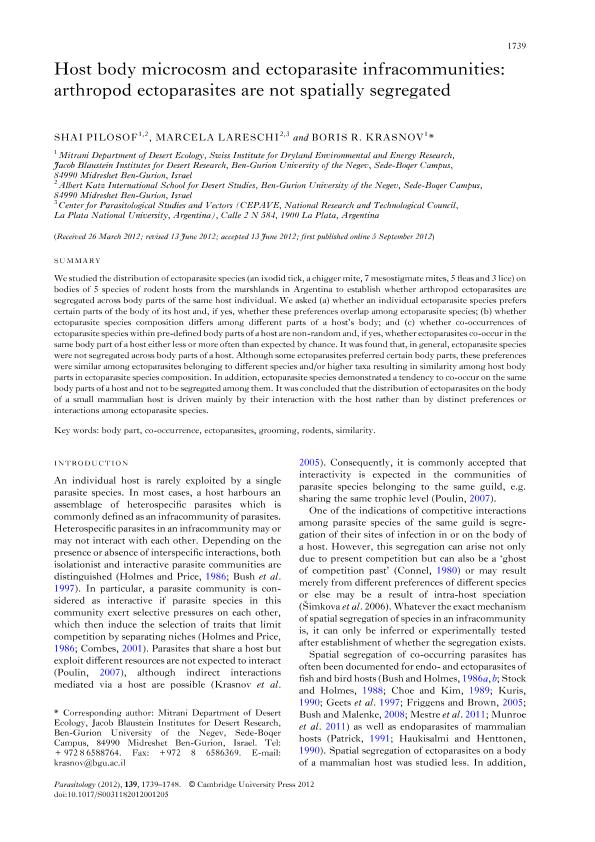Mostrar el registro sencillo del ítem
dc.contributor.author
Pilosof, Shai
dc.contributor.author
Lareschi, Marcela

dc.contributor.author
Krasnov, Boris R.
dc.date.available
2019-01-30T17:29:42Z
dc.date.issued
2012-11
dc.identifier.citation
Pilosof, Shai; Lareschi, Marcela; Krasnov, Boris R.; Host body microcosm and ectoparasite infracommunities: Arthropod ectoparasites are not spatially segregated; Cambridge University Press; Parasitology; 139; 13; 11-2012; 1739-1748
dc.identifier.issn
0031-1820
dc.identifier.uri
http://hdl.handle.net/11336/69005
dc.description.abstract
We studied the distribution of ectoparasite species (an ixodid tick, a chigger mite, 7 mesostigmate mites, 5 fleas and 3 lice) on bodies of 5 species of rodent hosts from the marshlands in Argentina to establish whether arthropod ectoparasites are segregated across body parts of the same host individual. We asked (a) whether an individual ectoparasite species prefers certain parts of the body of its host and, if yes, whether these preferences overlap among ectoparasite species; (b) whether ectoparasite species composition differs among different parts of a host's body; and (c) whether co-occurrences of ectoparasite species within pre-defined body parts of a host are non-random and, if yes, whether ectoparasites co-occur in the same body part of a host either less or more often than expected by chance. It was found that, in general, ectoparasite species were not segregated across body parts of a host. Although some ectoparasites preferred certain body parts, these preferences were similar among ectoparasites belonging to different species and/or higher taxa resulting in similarity among host body parts in ectoparasite species composition. In addition, ectoparasite species demonstrated a tendency to co-occur on the same body parts of a host and not to be segregated among them. It was concluded that the distribution of ectoparasites on the body of a small mammalian host is driven mainly by their interaction with the host rather than by distinct preferences or interactions among ectoparasite species.
dc.format
application/pdf
dc.language.iso
eng
dc.publisher
Cambridge University Press

dc.rights
info:eu-repo/semantics/openAccess
dc.rights.uri
https://creativecommons.org/licenses/by-nc-sa/2.5/ar/
dc.subject
Body Part
dc.subject
Co-Occurrence
dc.subject
Ectoparasites
dc.subject
Grooming
dc.subject
Rodents
dc.subject
Similarity
dc.subject.classification
Otras Ciencias Biológicas

dc.subject.classification
Ciencias Biológicas

dc.subject.classification
CIENCIAS NATURALES Y EXACTAS

dc.title
Host body microcosm and ectoparasite infracommunities: Arthropod ectoparasites are not spatially segregated
dc.type
info:eu-repo/semantics/article
dc.type
info:ar-repo/semantics/artículo
dc.type
info:eu-repo/semantics/publishedVersion
dc.date.updated
2019-01-10T17:46:20Z
dc.journal.volume
139
dc.journal.number
13
dc.journal.pagination
1739-1748
dc.journal.pais
Reino Unido

dc.journal.ciudad
Cambridge
dc.description.fil
Fil: Pilosof, Shai. Ben Gurion University of the Negev; Israel
dc.description.fil
Fil: Lareschi, Marcela. Consejo Nacional de Investigaciones Científicas y Técnicas. Centro Científico Tecnológico Conicet - La Plata. Centro de Estudios Parasitológicos y de Vectores. Universidad Nacional de La Plata. Facultad de Ciencias Naturales y Museo. Centro de Estudios Parasitológicos y de Vectores; Argentina. Ben Gurion University of the Negev; Israel
dc.description.fil
Fil: Krasnov, Boris R.. Ben Gurion University of the Negev; Israel
dc.journal.title
Parasitology

dc.relation.alternativeid
info:eu-repo/semantics/altIdentifier/url/https://www.cambridge.org/core/journals/parasitology/article/host-body-microcosm-and-ectoparasite-infracommunities-arthropod-ectoparasites-are-not-spatially-segregated/48D2AC378966195EBA71737AAFCE0116
dc.relation.alternativeid
info:eu-repo/semantics/altIdentifier/doi/http://dx.doi.org/10.1017/S0031182012001205
Archivos asociados
